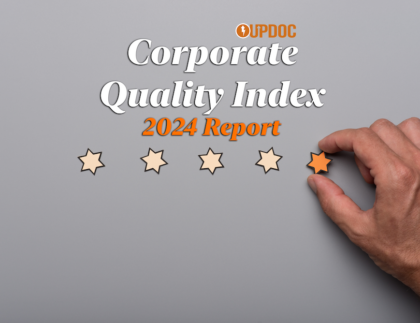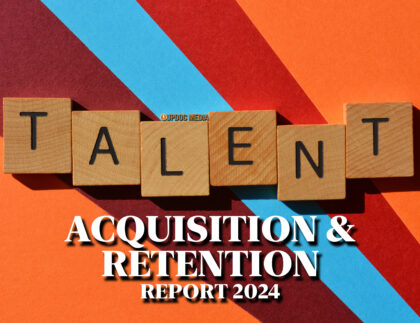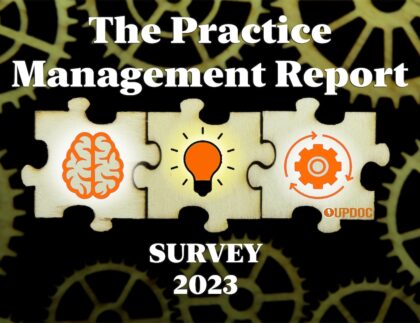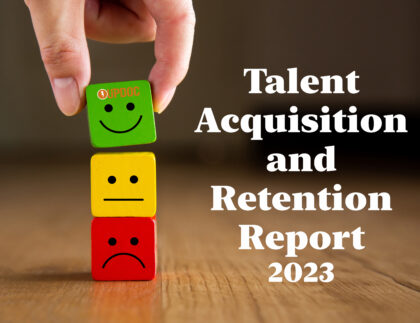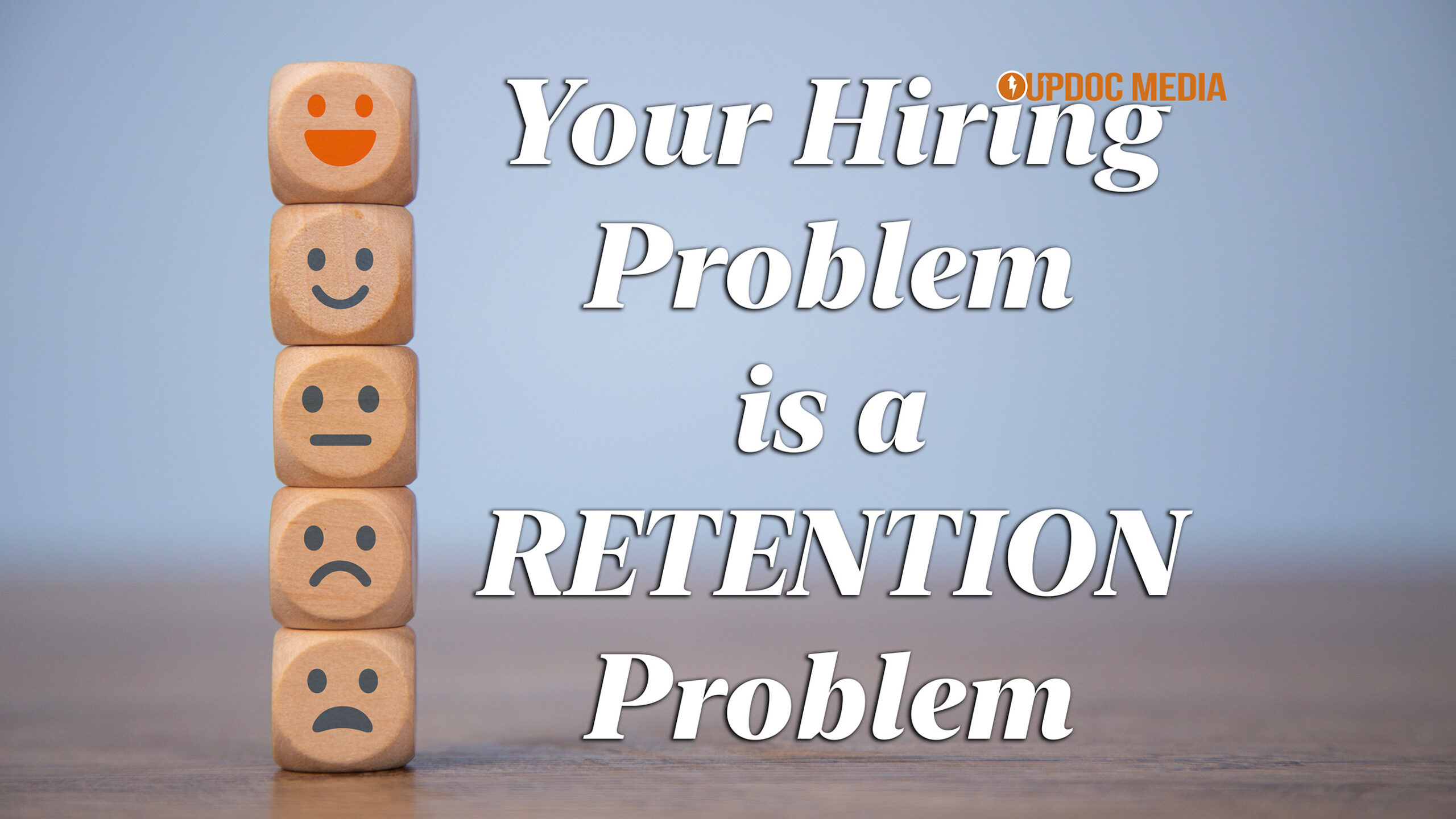
We know that less than half of workforce members are fully intending to stay with their employers for the next 12 perceivable months (Corporate Quality Index Report 2023; UpDoc, Inc.). In fact, per the 2024 Talent Acquisition and Retention Report, only 23% of talent respondents reported they were happy with their current employer and not actively seeking or browsing elsewhere.
From the 2023 Practice Management Report, we learned that 90% of practice managers were struggling with new hires, retention, or both.
Recently, UpDoc finally went live with our workforce intelligence platform HIYER™. The goal of this platform is employee engagement, retention, and putting employer organizations in a position of advantage for attracting new hires.
One of the benefits with UpDoc running live-trended data is that we can look back on data trends with the perspective of newer insights for clarity on the ever developing workforce quandaries we have yet to glean clear answers for — at least, not yet.
This brings us to the problem of Hiring and Retention.
Is your hiring problem really a hiring problem?
Spoiler alert. No, it’s not.
Now, we’re talking about hiring in terms of the macro of our physical therapy and allied rehab therapy industry. There will always be a statistical curve; and, if your practice or department isn’t struggling here — congratulations!
However, if you’re like the majority of employers out there — hiring is one of the biggest challenges in practice management and has been the case for the last decade or so… only accelerated by the 2020 disruptions.

Thanks, Captain Obvious.

Why is hiring actually a retention problem?
We know that correlation is not causation; however, correlation gives us incredible insights when you cluster statistically significant trends that paint a clear path as to what might be happening.
Sometimes, it’s Captain Obvious who needs to tell us the things we might just be too close to home to meaningfully notice.
One of such things is retention versus hiring. “Obviously” — if an employer can’t retain staff members, then they will need to continuously hire… creating a hiring problem.
However, what may be less obvious has to do with the underlying issues creating a chronic retention crisis — AND, how those underlying issues make for a challenging hiring environment.
The proof is in the (numbers) pudding.
After noticing some initial spikes through HIYER™, the team at UpDoc went back to review Talent Acquisition and Practice Management data sets to see if we can pinpoint the issues behind what pretty much every decision maker bemoaned as a hiring problem.
So, we commenced the data mining… and, we found some gold nuggets!

Initially, when we looked at the Retention versus Hiring challenges in the UpDoc stratum of data, we really didn’t find anything relational per se.
It just seemed that EVERYONE was struggling regardless of how their retention was going.
There was no relation to size or scale of the organization; those that had hiring problems, didn’t always seem to have retention problems — in fact, there was a small grouping of practice managers that stated they had no problems with hiring, but they note some resignation sprees in their organization.
Enter super obscure references / odd humor:

Combining the data we now have from HIYER™ with the Corporate Quality Index Report, the Practice Management Report, and our 2024 Talent Acquisition and Retention Report — we’ve discovered some interesting insights!
PS. Did you have any idea Star Wars Family Guy was referencing the Simpsons? I sure didn't... not until I did a GIF search.


Just in case you're wondering how I got here with the GIFs... I was looking for a "gold nugget" GIF, which lead me to Scrooge McDuck. That reminded me of Cornelius yelling, "SILVER!" Which then made me stumble across the Simpson's "Look! A penny" moment — which reminded me of the Star Wars Family Guy reference.
Crazy, right?
The new data insights!
When we reviewed the numbers between Acquisition and Retention under the light of new HIYER™ data, we noticed that there was a more clear correlation when looking at Hiring Difficulties as a downstream symptom of the underlying factors of Retention problems.
Looking at respondents from the end of year 2023 Practice Management Report, we saw that when respondents scored high with Retention challenges, they also scored high with hiring problems — however, that seemed to dip down a bit when it came to scoring low with Retention challenges.

The Pearson’s Correlation Coefficient in this case was 0.91, not exactly above the 95% that we typically like to see… but, it wasn’t random per se. There was something here.
Now, when diving further into the actual symptoms of the challenge, we got some fascinating numbers! We took the percentage of respondents that stated it would take more than 3 months to fill a new opening against what they stated was their level of retention challenge (1 being no challenge at all, and 5 being that retention is a huge challenge in their organization).
When tabulated, the relationship between the two became quite clear. The Pearson’s in this case was 0.962! Certainly above the 95% we like to see before we talk seriously about such issues.

The accentuation was this: If a hiring manager remarked that their struggles in retention were 5 out of 5 difficult, they have a 75% chance of requiring more than 3 months to fill an open position with a new hire.
Does it work in both directions?
When we looked at the reciprocity of this relationship, it wasn’t the same. Again, it was a sanity check against Captain Obvious. Was it really as simple as if: Organizations that kept losing people needed to keep hiring — a revolving door problem?
NOPE!
The reverse of this analysis showed a mere 0.6 relationship between decision makers who felt they were having hiring difficulties and the correlated retention problems to follow.
However, when looking at both data sets for Retention versus Hiring Challenges AND Retention versus TIME TO HIRE — the numbers couldn’t be more clear.
We know that nearly 80% of hiring managers are either actively recruiting or looking to pad their pool of candidates should the time come.
We also know that only 36% of hiring managers will fill a new role in 3 months or less — which is a MASSIVE difference in terms of costs to hire, loss of production, and secondary strains on both the line staff and hiring manager. In contrast, 40% of managers feel it’ll take at least half a year, if not more to fill a single opening (2024 Talent Acquisition and Retention Report by UpDoc, Inc.).
Are we too close to the problem?
From the 2023 end of year Practice Management Report, we know that many managers felt they didn’t have the tools for early detection of at risk employees in terms of retention. We also know that there were many managers who admitted that they simply didn't have the tools to be successful with Talent Acquisition and Retention.
As a brief overview:
- For the respondents who stated their greatest challenge moving into 2024 was related to staffing, only 42.9% mentioned that resignations were a huge problem for their company.
- For respondents who stated their greatest strength moving into 2024 was once again their people, culture, etc. — 57.9% remarked that attracting new hires was an incredible difficulty for them.
- For managers who stated their greatest challenge moving into 2024 was once again related to staffing: 92.9% marked they have problems attracting new talent.
Maybe... just maybe... Perhaps this is a case of us clinicians being great at human physiology, and not so great at workforce physiology?
Chasing the pain of workforce strategies.
In an up and coming UpDoc Media blog article, we’ll be covering the true cost of turnover in 2024. However, for now in short, let us run with what conventional wisdom (backed by A.I. calculations) states the general costs are:
- To fill a PT position in 3 months or less, it will cost 36% of the per annum salary equivalent to that position.
- To fill a PT position in 6 months or greater, it will cost the company 74% - 85% of the per annum salary equivalent to that position.
As healthcare clinicians, especially in the field of physical therapy and allied rehab therapy, we never advocate masking nor chasing pain around as a symptom of problems. We like figuring out root source causes.
Is it really a shortage?

Screen capture of a pending poll results dated 6/13/2024.
The classical case of referred pain from the lumbar spine is a great example. Without getting into an argument of best clinical practices, theoretical models, or the like… let’s just run with the example of a centralizing pain of the leg and foot with a patient who might initially be incredulous that a clinician is pointing to their back as the source of the problem and the treatment focus for exercise.
“But, it’s my FOOT that hurts… you’re telling me I have a back problem?”

Insert more odd humor that has pretty much the opposite thing to say about referred pain — but, I couldn't resist... it was GIF referencing the foot... from FRIENDS!

Back on topic...
We’ve all seen and heard this before when it comes to referring and centralizing pain, and we likely have all treated it with great success.
Now, let’s apply the same target focus to our workplace and employer organization.
If we keep chasing the pain of talent acquisition, we will keep missing the source cause of those symptoms which is increasingly being highlighted as a retention issue.
Managers and the Locus of Control
The fact is, if you as a hiring manager feel that you agree or strongly agree with having hiring challenges, then you likely have a retention problem as well — AND, very likely have underlying “spine problems” which are referring pain as a “hiring problem.”
Until you address the Retention (spine) issue… you’ll continue to have Hiring (foot) pains — all the while, symptomatic or not… your spine health is still problematic at best.
AND… until you do address such root causes, the masking of symptoms as a revolving workforce door will simply continue create further ailments to your organization — in the form of decrease production value, work team attrition, and turnover.

No doubt, if you're a decision maker or hiring manager at any level, you've seen more and more headlines about the difficulties of workforce strategies as we head to the latter half of the 2020s.
Middle management is in question, line managers are pressured from all sides, and upper/senior business leaders see the problems all too clearly — but, lack the analytical tools to either identify root problem sets, or to track changes when they initiate prudent management levers.

UpDoc's Workforce Intelligence Platform: HIYER™
As of Summer of 2024, UpDoc has officially launched our workforce intelligence platform called HIYER™.
It delivers live-trended staff driven data for the purpose of talent acquisition and retention; focusing first on internal levers to retention as it is definitively the root source for building a strong foundation for a competitive hiring strategy.
HIYER™ is calibrated for the physical therapy and allied rehab therapy space, and goes far beyond a generic annual employee satisfaction survey. It dives into group segmented multivariate analysis with clear analysis, trackable management levers, and agile results.
